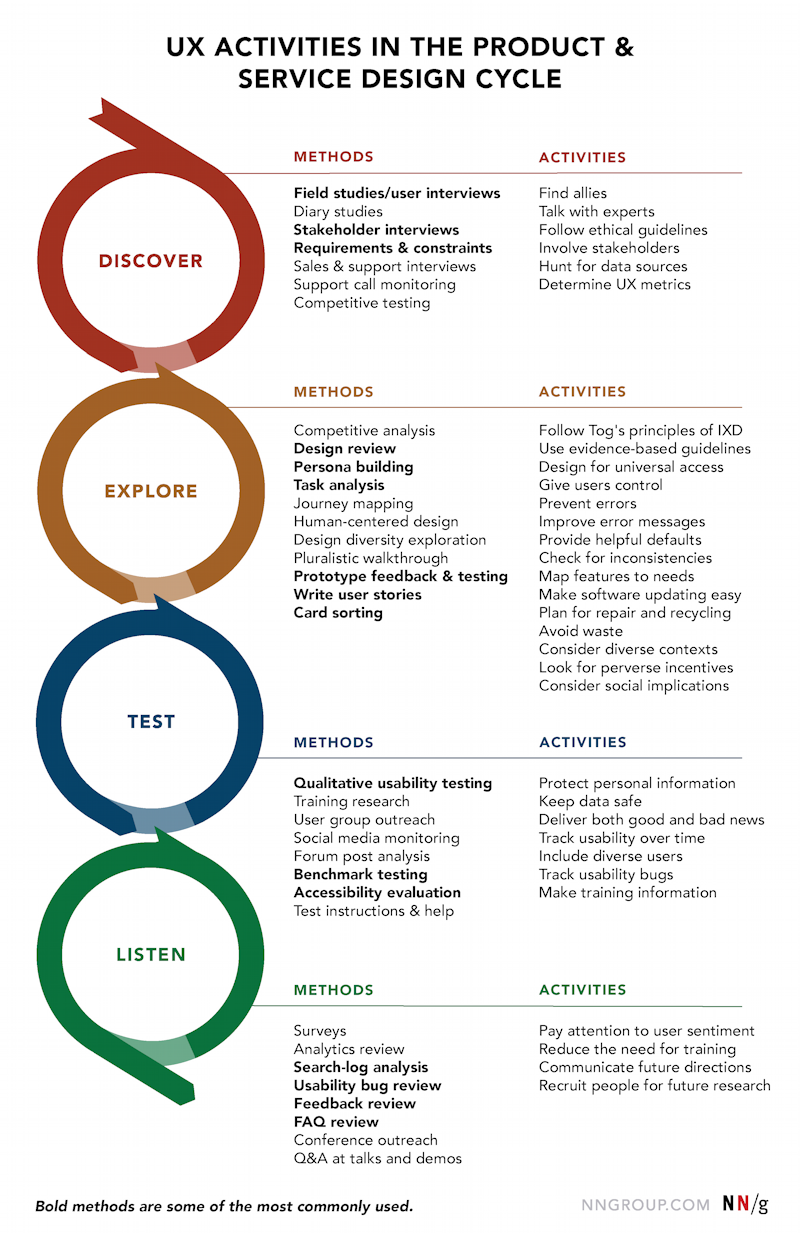The Complete Guide to UX Research Methods
UX research provides invaluable insight into product users and what they need and value. Not only will research reduce the risk of a miscalculated guess, it will uncover new opportunities for innovation.
UX research provides invaluable insight into product users and what they need and value. Not only will research reduce the risk of a miscalculated guess, it will uncover new opportunities for innovation.
Miklos is a UX designer, product design strategist, author, and speaker with more than 18 years of experience in the design field.
Expertise
PREVIOUSLY AT

“Empathy is at the heart of design. Without the understanding of what others see, feel, and experience, design is a pointless task.” —Tim Brown, CEO of the innovation and design firm IDEO
User experience (UX) design is the process of designing products that are useful, easy to use, and a pleasure to engage. It’s about enhancing the entire experience people have while interacting with a product and making sure they find value, satisfaction, and delight. If a mountain peak represents that goal, employing various types of UX research is the path UX designers use to get to the top of the mountain.
User experience research is one of the most misunderstood yet critical steps in UX design. Sometimes treated as an afterthought or an unaffordable luxury, UX research, and user testing should inform every design decision.
Every product, service, or user interface designers create in the safety and comfort of their workplaces has to survive and prosper in the real world. Countless people will engage our creations in an unpredictable environment over which designers have no control. UX research is the key to grounding ideas in reality and improving the odds of success, but research can be a scary word. It may sound like money we don’t have, time we can’t spare, and expertise we have to seek.
In order to do UX research effectively—to get a clear picture of what users think and why they do what they do—e.g., to “walk a mile in the user’s shoes” as a favorite UX maxim goes, it is essential that user experience designers and product teams conduct user research often and regularly. Contingent upon time, resources, and budget, the deeper they can dive the better.

What Is UX Research?
There is a long, comprehensive list of UX design research methods employed by user researchers, but at its center is the user and how they think and behave—their needs and motivations. Typically, UX research does this through observation techniques, task analysis, and other feedback methodologies.
There are two main types of user research: quantitative (statistics: can be calculated and computed; focuses on numbers and mathematical calculations) and qualitative (insights: concerned with descriptions, which can be observed but cannot be computed).
-
Quantitative research is primarily exploratory research and is used to quantify the problem by way of generating numerical data or data that can be transformed into usable statistics. Some common data collection methods include various forms of surveys – online surveys, paper surveys, mobile surveys and kiosk surveys, longitudinal studies, website interceptors, online polls, and systematic observations.
This user research method may also include analytics, such as Google Analytics.
Google Analytics is part of a suite of interconnected tools that help interpret data on your site’s visitors including Data Studio, a powerful data-visualization tool, and Google Optimize, for running and analyzing dynamic A/B testing.
Quantitative data from analytics platforms should ideally be balanced with qualitative insights gathered from other UX testing methods, such as focus groups or usability testing. The analytical data will show patterns that may be useful for deciding what assumptions to test further.
-
Qualitative user research is a direct assessment of behavior based on observation. It’s about understanding people’s beliefs and practices on their terms. It can involve several different methods including contextual observation, ethnographic studies, interviews, field studies, and moderated usability tests.

Jakob Nielsen of the Nielsen Norman Group feels that in the case of UX research, it is better to emphasize insights (qualitative research) and that although quant has some advantages, qualitative research breaks down complicated information so it’s easy to understand, and overall delivers better results more cost effectively—in other words, it is much cheaper to find and fix problems during the design phase before you start to build. Often the most important information is not quantifiable, and he goes on to suggest that “quantitative studies are often too narrow to be useful and are sometimes directly misleading.”
Not everything that can be counted counts, and not everything that counts can be counted.
William Bruce Cameron
Design research is not typical of traditional science with ethnography being its closest equivalent—effective usability is contextual and depends on a broad understanding of human behavior if it is going to work.
Nevertheless, the types of user research you can or should perform will depend on the type of site, system or app you are developing, your timeline, and your environment.

Top UX Research Methods and When to Use Them
Here are some examples of the types of user research performed at each phase of a project.
Card Sorting: Allows users to group and sort a site’s information into a logical structure that will typically drive navigation and the site’s information architecture. This helps ensure that the site structure matches the way users think.
Contextual Interviews: Enables the observation of users in their natural environment, giving you a better understanding of the way users work.
First Click Testing: A testing method focused on navigation, which can be performed on a functioning website, a prototype, or a wireframe.
Focus Groups: Moderated discussion with a group of users, allowing insight into user attitudes, ideas, and desires.
Heuristic Evaluation/Expert Review: A group of usability experts evaluating a website against a list of established guidelines.
Interviews: One-on-one discussions with users show how a particular user works. They enable you to get detailed information about a user’s attitudes, desires, and experiences.
Parallel Design: A design methodology that involves several designers pursuing the same effort simultaneously but independently, with the intention to combine the best aspects of each for the ultimate solution.
Personas: The creation of a representative user based on available data and user interviews. Though the personal details of the persona may be fictional, the information used to create the user type is not.
Prototyping: Allows the design team to explore ideas before implementing them by creating a mock-up of the site. A prototype can range from a paper mock-up to interactive HTML pages.
Surveys: A series of questions asked to multiple users of your website that help you learn about the people who visit your site.
System Usability Scale (SUS): SUS is a technology-independent ten-item scale for subjective evaluation of the usability.
Task Analysis: Involves learning about user goals, including what users want to do on your website, and helps you understand the tasks that users will perform on your site.
Usability Testing: Identifies user frustrations and problems with a site through one-on-one sessions where a “real-life” user performs tasks on the site being studied.
Use Cases: Provide a description of how users use a particular feature of your website. They provide a detailed look at how users interact with the site, including the steps users take to accomplish each task.
You can do user research at all stages or whatever stage you are in currently. However, the Nielsen Norman Group advises that most of it be done during the earlier phases when it will have the biggest impact. They also suggest it’s a good idea to save some of your budget for additional research that may become necessary (or helpful) later in the project.
Here is a diagram listing recommended options that can be done as a project moves through the design stages. The process will vary, and may only include a few things on the list during each phase. The most frequently used methods are shown in bold.

Reasons for Doing UX Research
Here are three great reasons for doing user research:
-
To create a product that is truly relevant to users
- If you don’t have a clear understanding of your users and their mental models, you have no way of knowing whether your design will be relevant. A design that is not relevant to its target audience will never be a success.
-
To create a product that is easy and pleasurable to use
- A favorite quote from Steve Jobs: “If the user is having a problem, it’s our problem.” If your user experience is not optimal, chances are that people will move on to another product.
-
To have the return on investment (ROI) of user experience design validated and be able to show:
- An improvement in performance and credibility
- Increased exposure and sales—growth in customer base
- A reduced burden on resources—more efficient work processes
Aside from the reasons mentioned above, doing user research gives insight into which features to prioritize, and in general, helps develop clarity around a project.

What Results Can I Expect from UX Research?
In the words of Mike Kuniaysky, user research is “the process of understanding the impact of design on an audience.”
User research has been essential to the success of behemoths like USAA and Amazon; Joe Gebbia, CEO of Airbnb is an enthusiastic proponent, testifying that its implementation helped turn things around for the company when it was floundering as an early startup.
Some of the results generated through UX research confirm that improving the usability of a site or app will:
- Increase conversion rates
- Increase sign-ups
- Increase NPS (net promoter score)
- Increase customer satisfaction
- Increase purchase rates
- Boost loyalty to the brand
- Reduce customer service calls
Additionally, and aside from benefiting the overall user experience, the integration of UX research into the development process can:
- Minimize development time
- Reduce production costs
- Uncover valuable insights about your audience
- Give an in-depth view into users’ mental models, pain points, and goals
Conclusion
User research is at the core of every exceptional user experience. As the name suggests, UX is subjective—the experience that a person goes through while using a product. Therefore, it is necessary to understand the needs and goals of potential users, the context, and their tasks which are unique for each product. By selecting appropriate UX research methods and applying them rigorously, designers can shape a product’s design and can come up with products that serve both customers and businesses more effectively.
Further Reading on the Toptal Blog:
Understanding the basics
How do you do user research in UX?
UX research includes two main types: quantitative (statistical data) and qualitative (insights that can be observed but not computed), done through observation techniques, task analysis, and other feedback methodologies. The UX research methods used depend on the type of site, system, or app being developed.
What are UX methods?
There is a long list of methods employed by user research, but at its center is the user and how they think, behave—their needs and motivations. Typically, UX research does this through observation techniques, task analysis, and other UX methodologies.
What is the best research methodology for user experience design?
The type of UX methodology depends on the type of site, system or app being developed, its timeline, and environment. There are 2 main types: quantitative (statistics) and qualitative (insights).
What does a UX researcher do?
A user researcher removes the need for false assumptions and guesswork by using observation techniques, task analysis, and other feedback methodologies to understand a user’s motivation, behavior, and needs.
Why is UX research important?
UX research will help create a product that is relevant to users and is easy and pleasurable to use while boosting a product’s ROI. Aside from these reasons, user research gives insight into which features to prioritize, and in general, helps develop clarity around a project.
Miklos Philips
London, United Kingdom
Member since May 20, 2016
About the author
Miklos is a UX designer, product design strategist, author, and speaker with more than 18 years of experience in the design field.
Expertise
PREVIOUSLY AT



